Transforming your backyard into a private oasis doesn’t have to break the bank. Fences offer a multitude of benefits, from creating a haven of privacy to containing playful pets and enhancing the overall aesthetic of your outdoor space. However, traditional fence installations can come with a hefty price tag.
This is where the magic of DIY comes in! With a touch of creativity and some readily available materials, you can construct a beautiful and functional fence for your backyard without compromising your budget. Here are 21 inspiring and cost-effective DIY fence ideas to get you started:
1. Embrace the Living Fence:
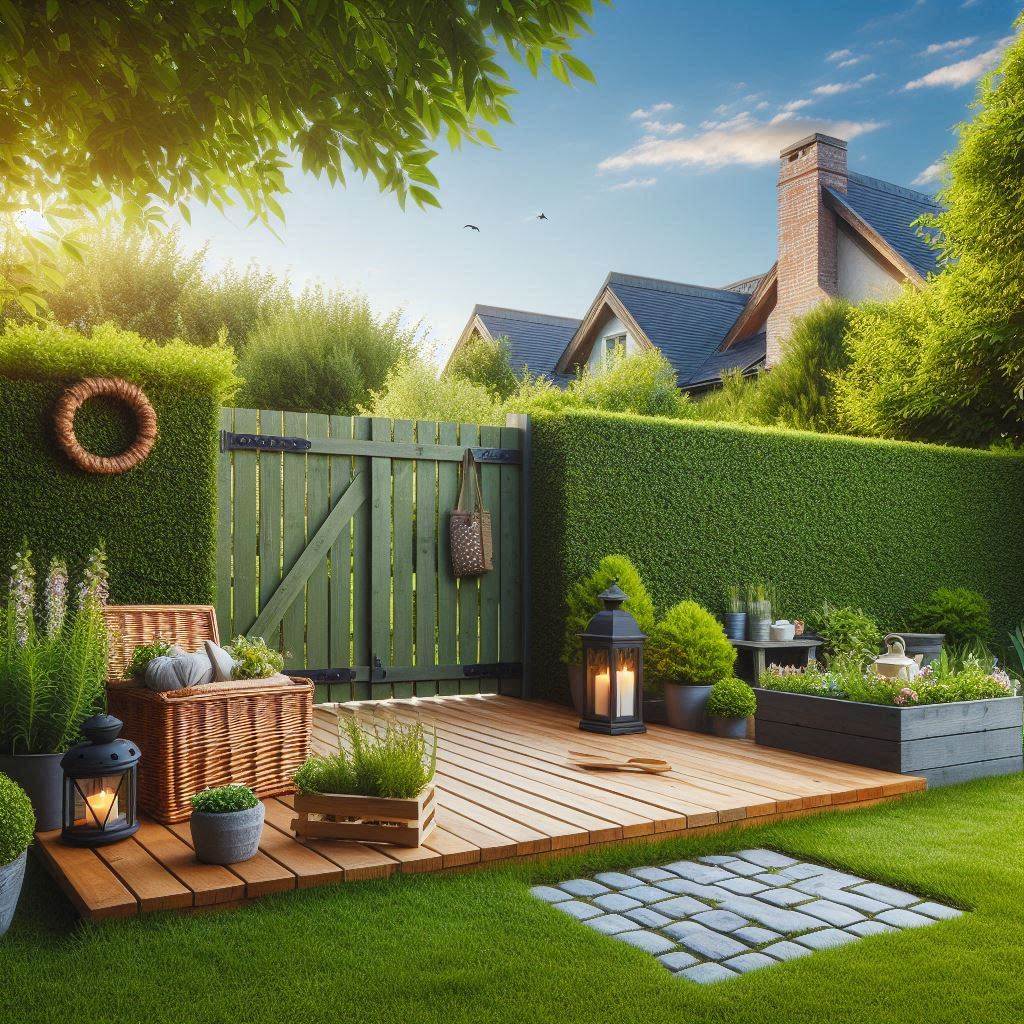
Nature lovers, rejoice! A living fence utilizes fast-growing hedges or climbing vines to create a natural barrier. This eco-friendly option not only provides privacy but also adds a touch of greenery and attracts pollinators to your backyard.
Suitable Plants:
- Hedges: Holly, Arborvitae, Privet, Boxwood (known for their dense foliage)
- Vines: Clematis, Wisteria, Trumpet Vine (fast-growing and visually appealing)
Planting and Maintenance:
- Research the specific planting requirements for your chosen plants, considering sunlight, soil type, and watering needs.
- Dig a trench along your desired fence line and space your plants according to their mature size.
- Water regularly during the establishment period and prune strategically to maintain the desired shape and size.
2. Repurpose with a Recycled Pallet Fence:
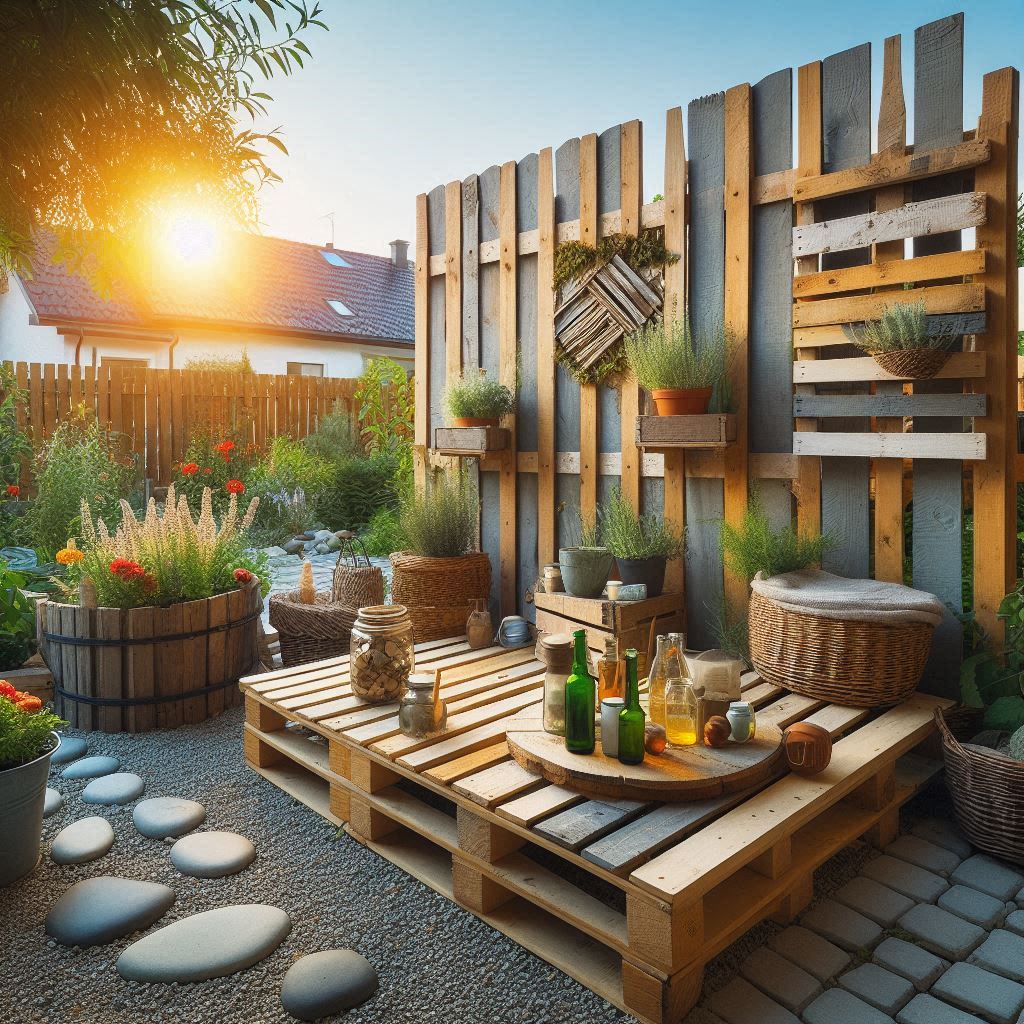
For a rustic and budget-friendly choice, consider a recycled pallet fence. Pallets are readily available at many businesses and often free for the taking. With a little effort, you can transform them into a sturdy and unique fence for your backyard.
Benefits of Pallet Fences:
- Affordability: Reclaimed pallets offer significant cost savings compared to traditional fence materials.
- Easy Assembly: Pallets have a pre-built frame, simplifying the construction process.
Preparing and Assembling Pallets:
- Disassemble the pallets, removing any loose nails or staples. Sand down any rough edges to ensure a smooth finish.
- Decide on the desired fence height and cut the pallets to size if needed.
- Secure the pallets to fence posts (treated wood is recommended) using galvanized screws or nails.
- You can stain or paint the pallets for a touch of personalization.
3. Weave a Whimsical Branch Fence:
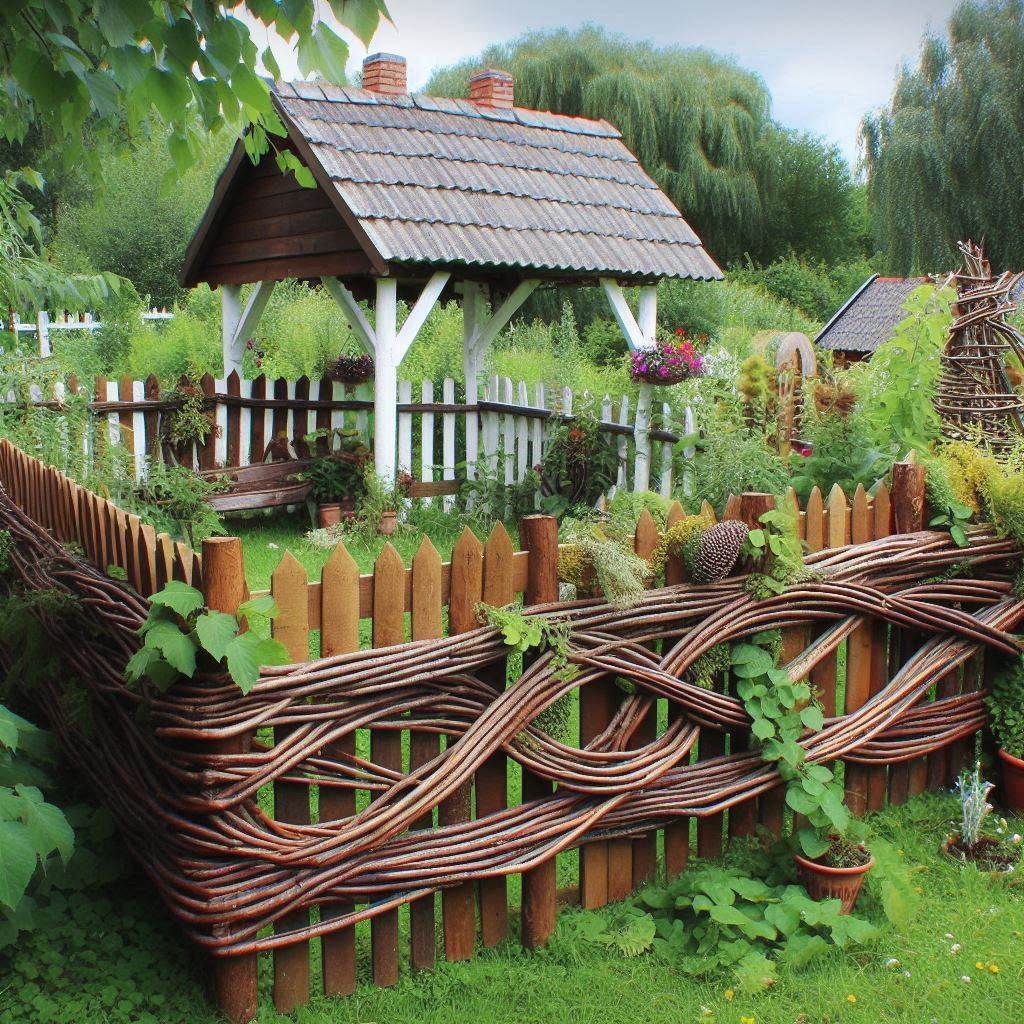
Bring a touch of rustic charm to your backyard with a woven branch fence. Utilize natural branches from your yard or fallen trees in your neighborhood (with permission, of course) to create a one-of-a-kind fence that complements your landscaping.
Choosing the Right Wood:
- Opt for branches that are flexible yet sturdy, such as willow, hazel, or dogwood.
- Ensure the branches are relatively straight and free from major knots or breaks.
Branch Preparation and Weaving Techniques:
- Cut the branches to similar lengths and soak them in water for a few days to increase flexibility.
- Secure sturdy posts into the ground to serve as the framework for your fence.
- Start weaving the branches horizontally between the posts, alternating directions for a secure hold.
- You can use twine or wire to secure the branches initially, removing them once the weave is complete.
4. Upcycle with a Vibrant Bottle Fence:
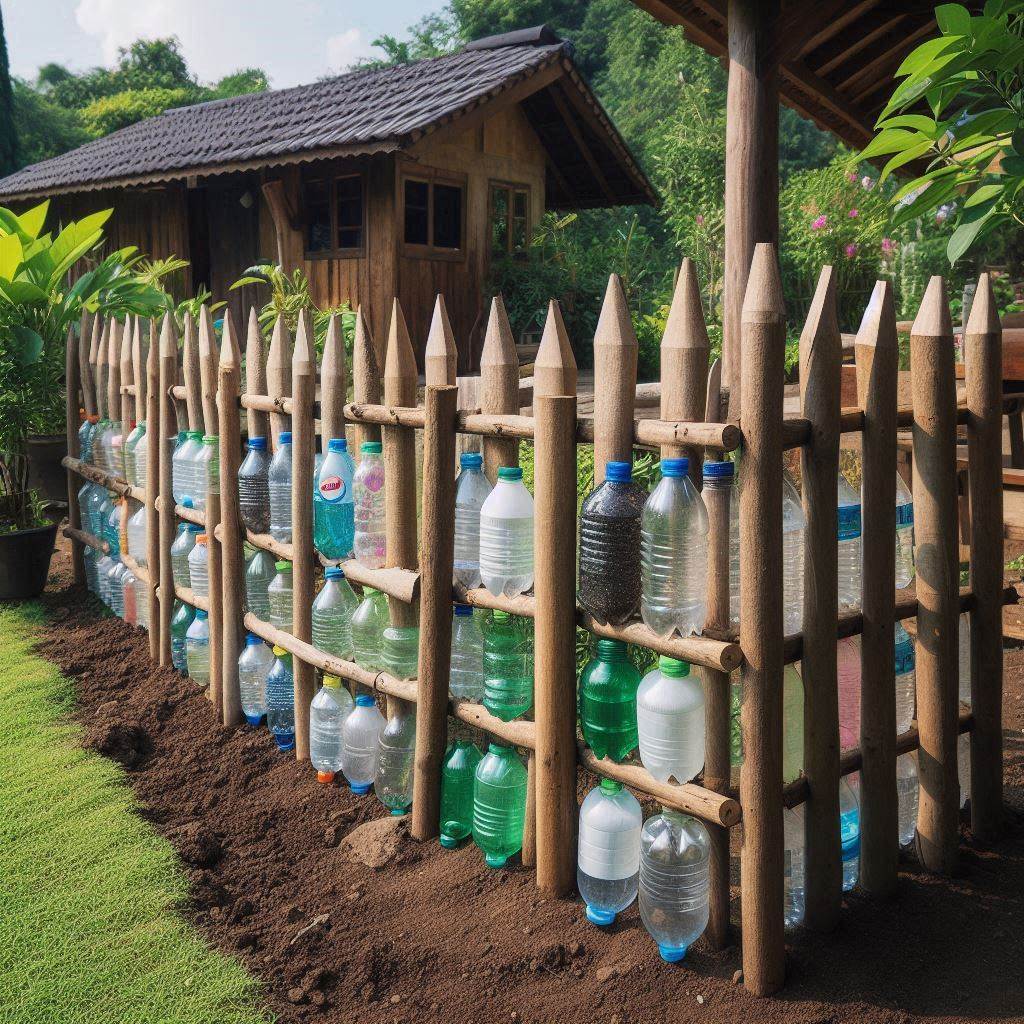
Think outside the box (or bottle!) with an upcycled bottle fence. This eco-conscious option allows you to breathe new life into glass or plastic bottles, creating a colorful and eye-catching fence for your backyard.
Collecting and Preparing Bottles:
- Gather used glass or plastic bottles in various sizes and colors. Ensure they are thoroughly washed and dried.
- Sand down any sharp edges, particularly for glass bottles, to prevent cuts during handling.
Stringing Methods and Design Ideas:
- Drill holes in the center of the bottom and top of each bottle.
- String fishing wire, twine, or even yarn through the holes, creating rows or patterns with the different colored bottles.
- Secure the strung bottles to a fence frame made from wood or metal posts.
- Experiment with different bottle arrangements to create unique designs and mosaics.
5. Let Nature Climb with Chicken Wire and Plants:
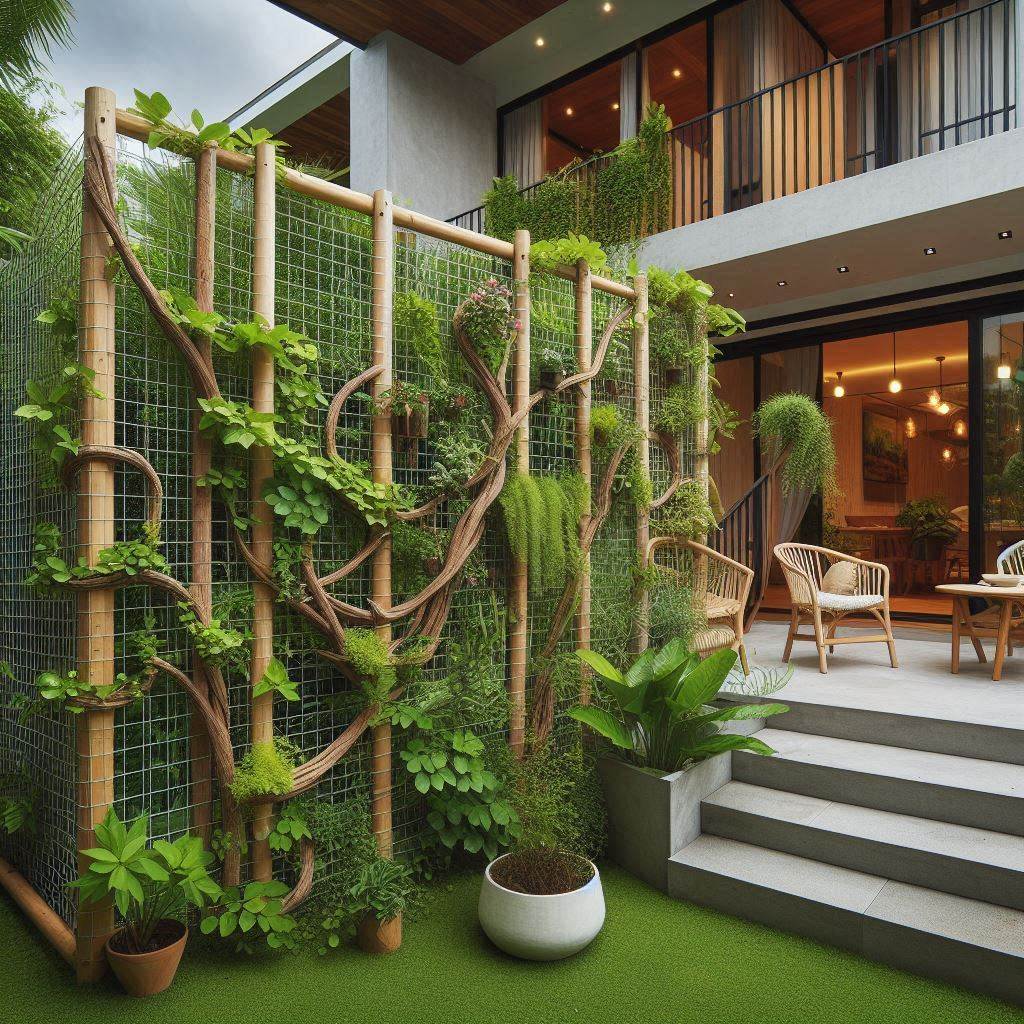
Here’s a budget-friendly option that allows you to cultivate a living fence with minimal effort. Chicken wire, readily available at most hardware stores, provides a sturdy base for climbing plants to create a natural and visually appealing barrier.
Climbing Plants for Chicken Wire Fences:
- Morning glories (fast-growing with vibrant blooms)
- Honeysuckle (fragrant flowers and attracts pollinators)
- Virginia creeper (dense foliage provides good privacy screening)
Installing the Chicken Wire and Plant Maintenance:
- Secure chicken wire to sturdy fence posts with staples or nails.
- Create a planting trench along the base of the chicken wire fence. Choose climbing plants that suit your climate and sunlight conditions.
- Plant your chosen vines at appropriate intervals and train them to climb the chicken wire as they grow.
- Regularly water your plants and provide additional support if needed. With proper care, your climbing plants will soon transform the chicken wire into a lush green fence.
6. Get Creative with a Painted Wood Scraps Fence:
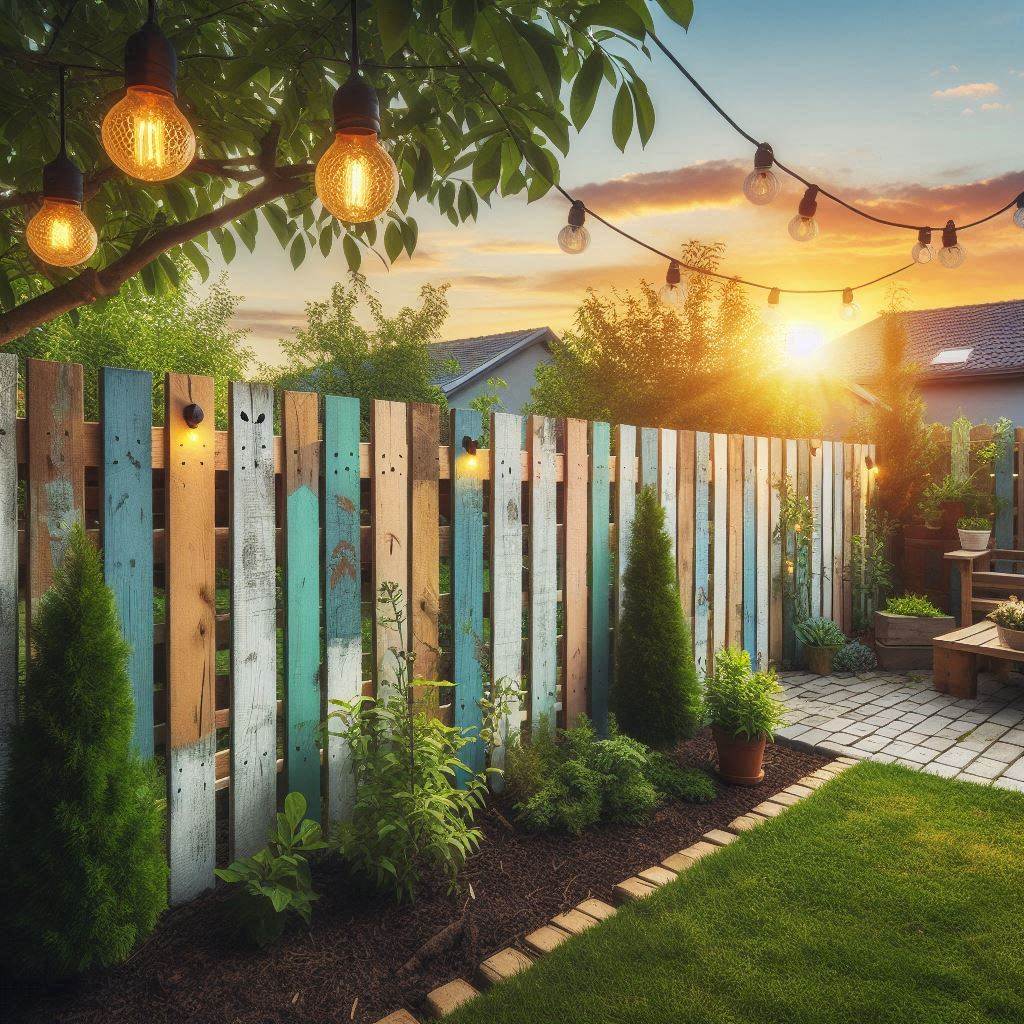
Do you have leftover wood scraps or salvaged lumber lying around? Don’t throw them away! With a little creativity and some paint, you can transform these scraps into a one-of-a-kind fence for your backyard.
Choosing Wood and Treatment:
- Select wood scraps that are relatively sturdy and free from excessive rot or warping.
- Ensure the wood is treated for outdoor use, especially if it will be in direct contact with the ground.
Cutting Techniques and Painting Ideas:
- Utilize a jigsaw or circular saw to cut the wood scraps into various lengths and shapes.
- Experiment with different arrangements to create a unique design, such as a picket fence or a more abstract pattern.
- Sand down the wood scraps for a smooth finish and unleash your inner artist! Paint the fence in a single bold color, create a color palette, or add decorative patterns.
7. Light Up Your Nights with a Mason Jar Solar Light Fence:
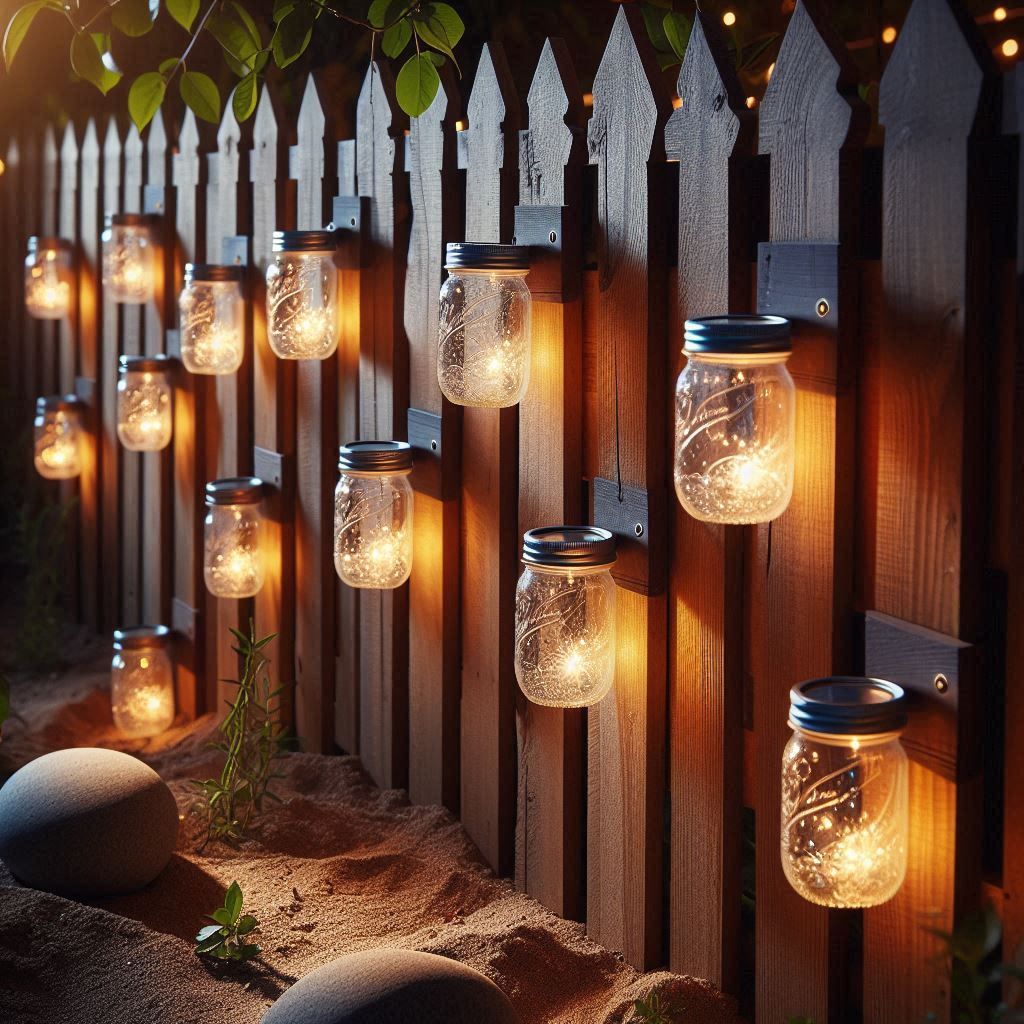
Here’s a unique and charming DIY fence idea that combines function with ambiance. Repurposed mason jars and solar lights can be transformed into a whimsical fence that adds a touch of magic to your backyard, especially during evenings.
Collecting and Preparing Mason Jars:
- Gather clean mason jars of various sizes. Wash them thoroughly and remove any labels or stickers.
- Using a drill with a glass drill bit (wear safety glasses!), create holes in the lids of the mason jars to allow for the solar light fixture to pass through.
Attaching Jars and Adding Solar Lights:
- Secure the mason jars to a pre-built fence structure using metal brackets or sturdy wire. Ensure the jars are spaced evenly and hang securely.
- Choose solar lights that fit snugly inside the mason jars. Opt for warm white or colored lights to create your desired ambiance.
- Screw the solar light fixtures into the lids of the mason jars, ensuring a weatherproof connection.
8. Embrace the Classic: The DIY Picket Fence
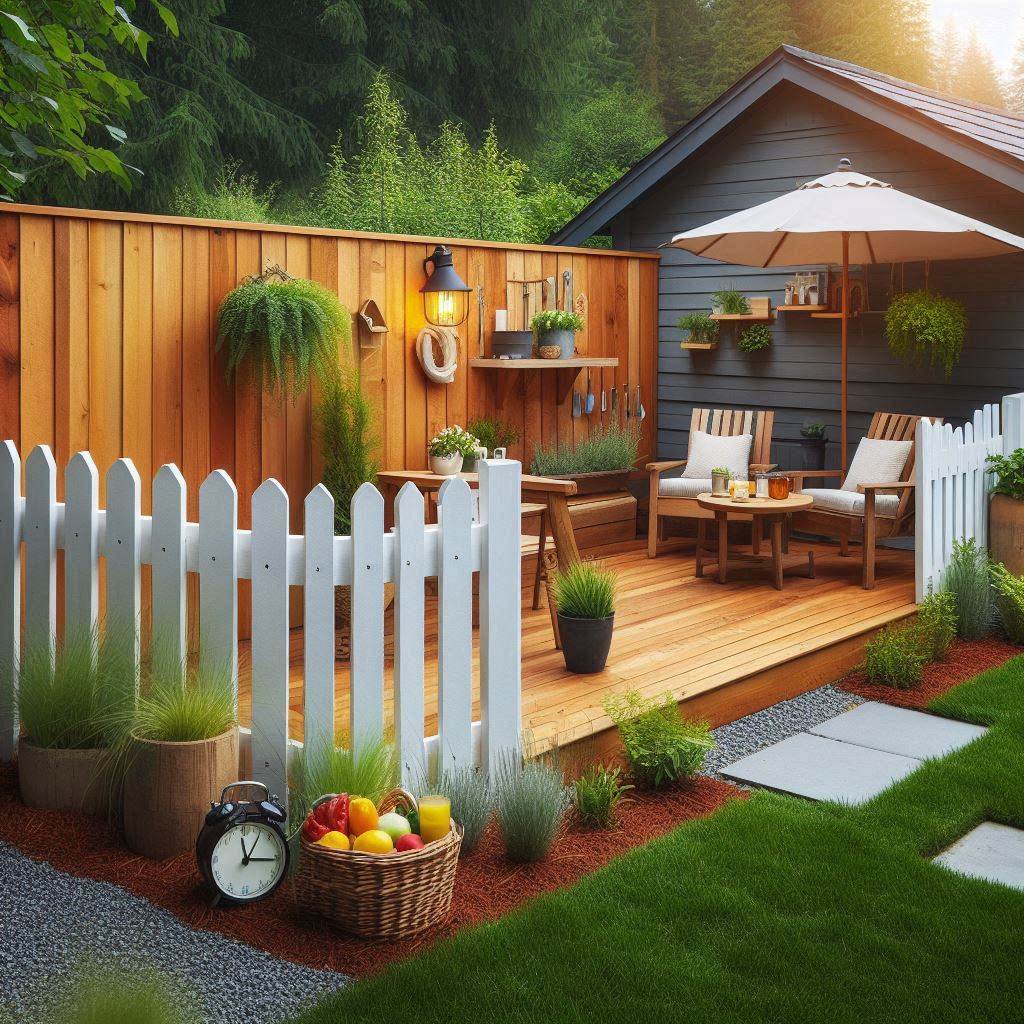
For a timeless and elegant touch, consider building a picket fence. While pre-made picket fences can be expensive, constructing your own allows for customization and cost savings.
Materials:
- Pickets (square or pointed tops) made from pressure-treated wood
- Rails (horizontal boards) made from pressure-treated wood
- Fence posts (treated wood)
- Galvanized nails or screws
Construction Tips:
- Determine the desired fence height and purchase pickets and rails accordingly.
- Secure the fence posts into the ground at regular intervals, ensuring they are level and plumb.
- Attach the rails to the posts using galvanized nails or screws.
- Evenly space and secure the pickets to the rails, creating a classic picket fence design.
9. Channel Coastal Vibes with a Reed Fence
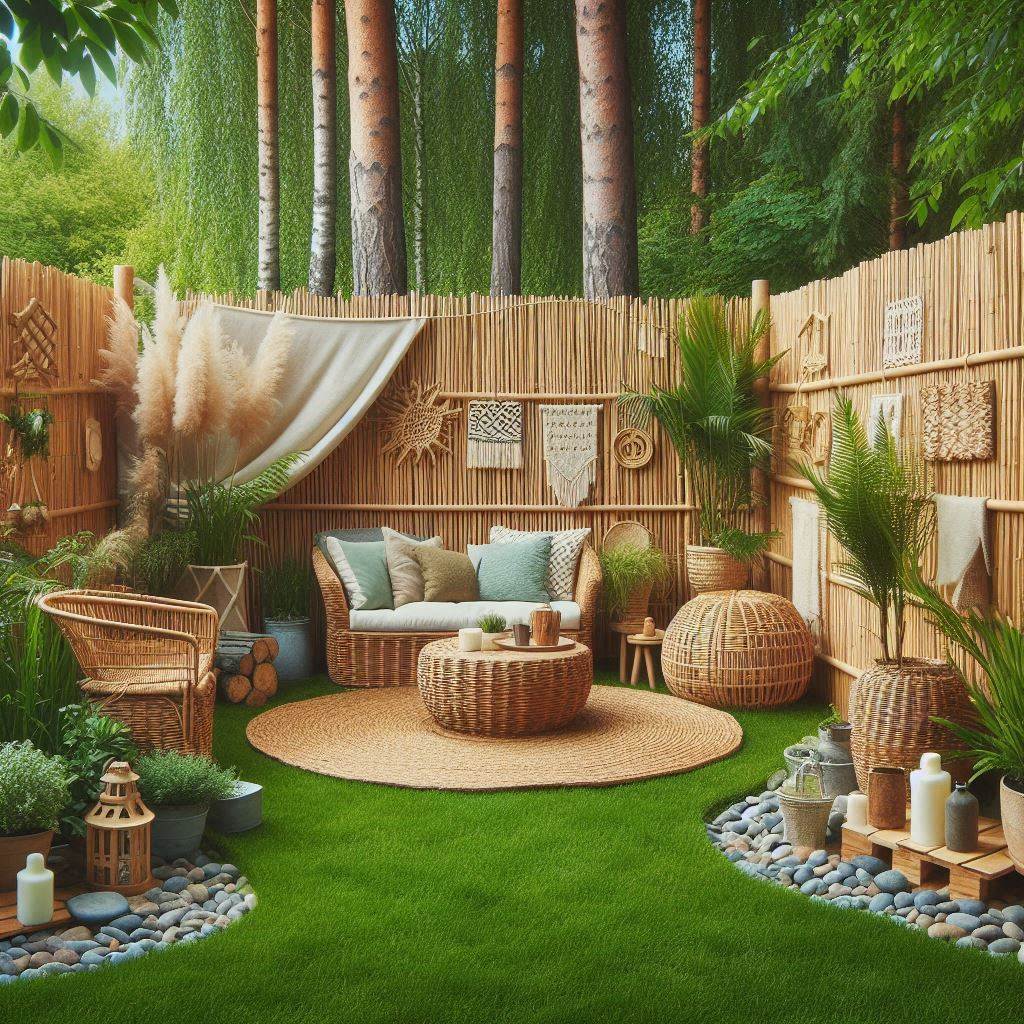
For a natural and eco-friendly option with a coastal feel, consider a reed fence. Reeds are readily available in wetland areas and offer a unique aesthetic.
Materials:
- Dried reeds (ensure they are thoroughly cured)
- Wire mesh panels
- Galvanized staples or zip ties
Construction Tips:
- Purchase pre-made wire mesh panels of the desired fence height.
- Securely bundle the dried reeds together with twine or wire.
- Attach the reed bundles horizontally across the wire mesh panel using galvanized staples or zip ties.
- Repeat the process until the entire wire mesh panel is covered with reeds.
- Secure the completed reed panels to fence posts using appropriate hardware.
10. Create a Rustic Barrier with a Split Rail Fence
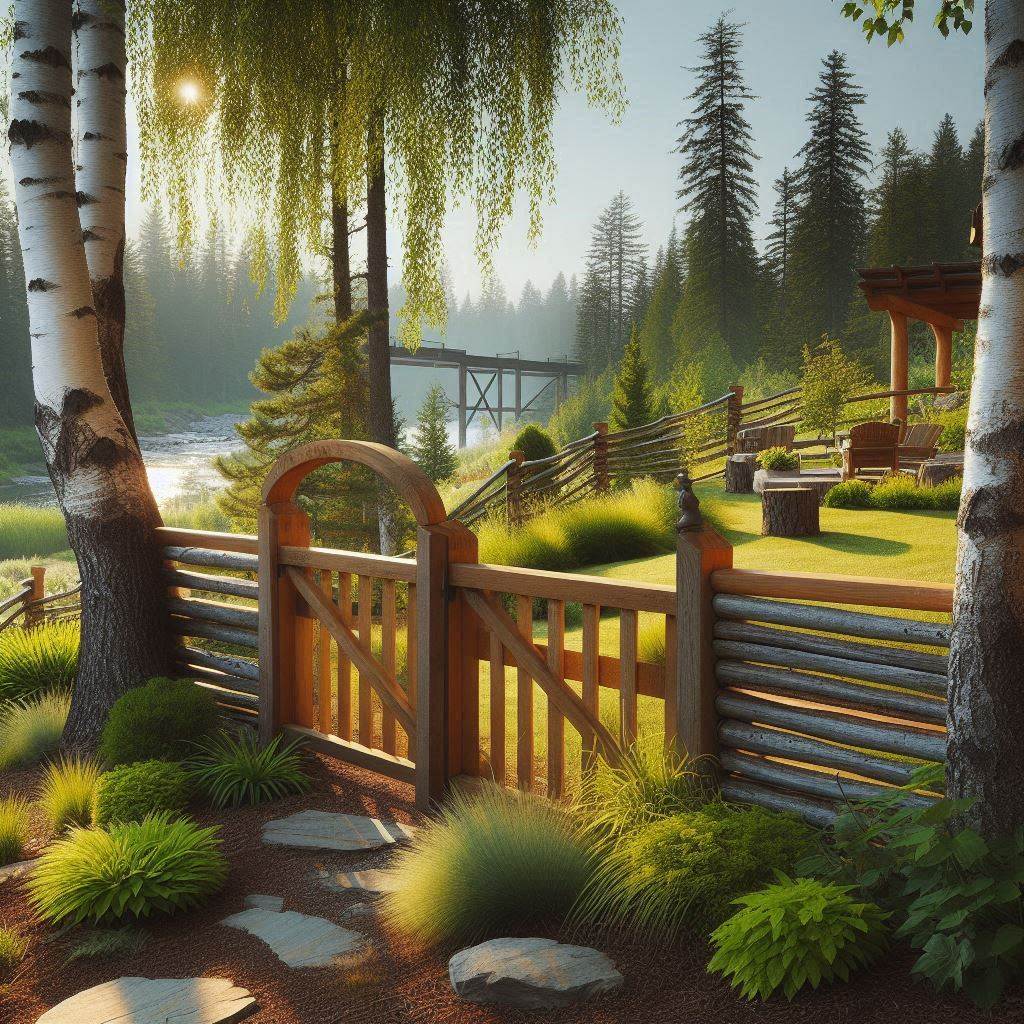
For a rustic and low-maintenance fence option, consider a split rail fence. Split rails are sections of logs split lengthwise, creating a natural and sturdy barrier.
Materials:
- Split logs (ideally seasoned hardwood)
- Fence posts (treated wood)
- Wooden wedges or metal brackets
Construction Tips:
- Dig holes for the fence posts and secure them into the ground, ensuring they are level and spaced evenly.
- Rest the split rails horizontally between the posts, creating a staggered pattern.
- Secure the split rails to the posts using wooden wedges or metal brackets.
11. Upcycle with a Fabric Fence
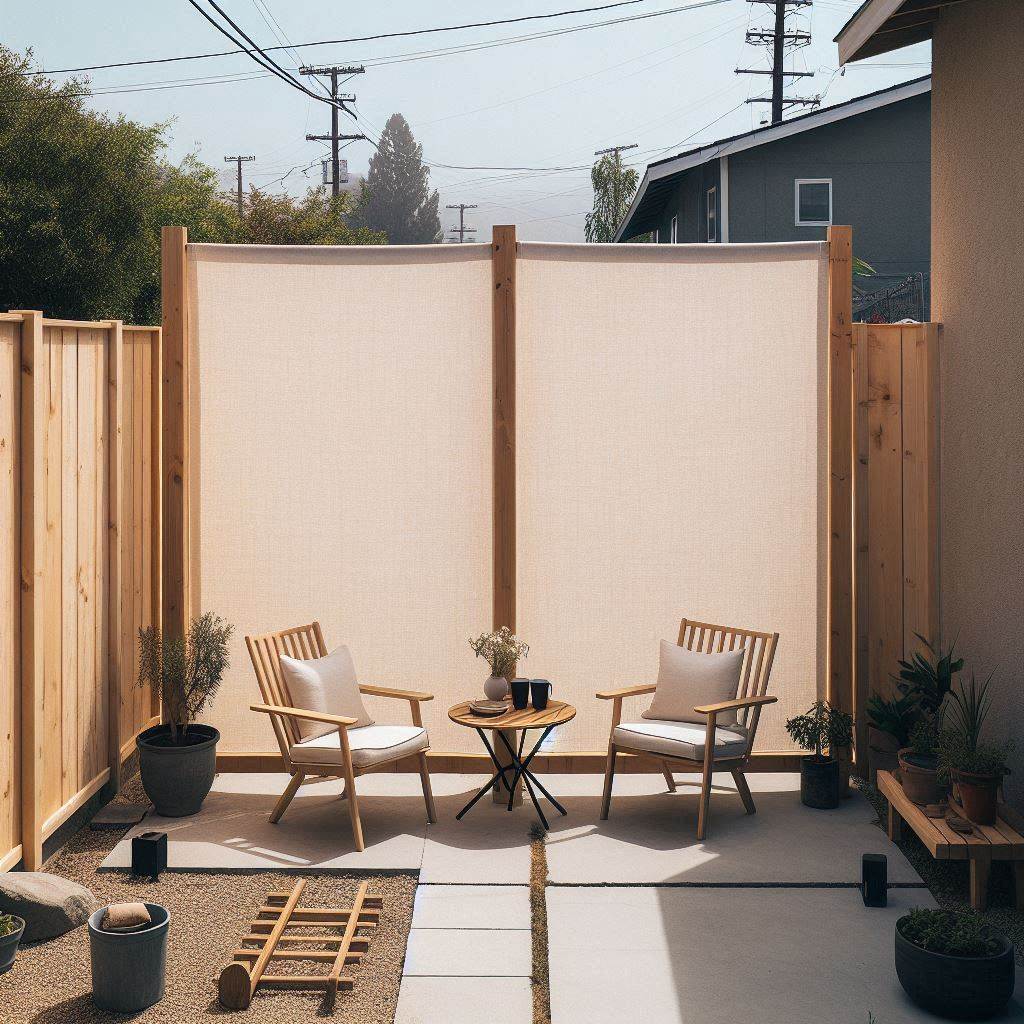
For a temporary or decorative fence solution, consider an upcycled fabric fence. This option allows for easy customization and can be a great way to add a pop of color or pattern to your backyard.
Materials:
- Sturdy fabric (canvas, outdoor tablecloth)
- Cable wire or galvanized wire rope
- Fence posts (treated wood or metal)
- Eye hooks or turnbuckles
Construction Tips:
- Secure the fence posts into the ground at regular intervals.
- Attach cable wire or galvanized wire rope between the posts at the top and bottom to create a frame.
- Sew pockets on the top and bottom of the fabric panel to accommodate the cable wire.
- Slide the fabric panel onto the cable wire and secure it using eye hooks or turnbuckles.
12. Embrace Simplicity with a Rope Fence
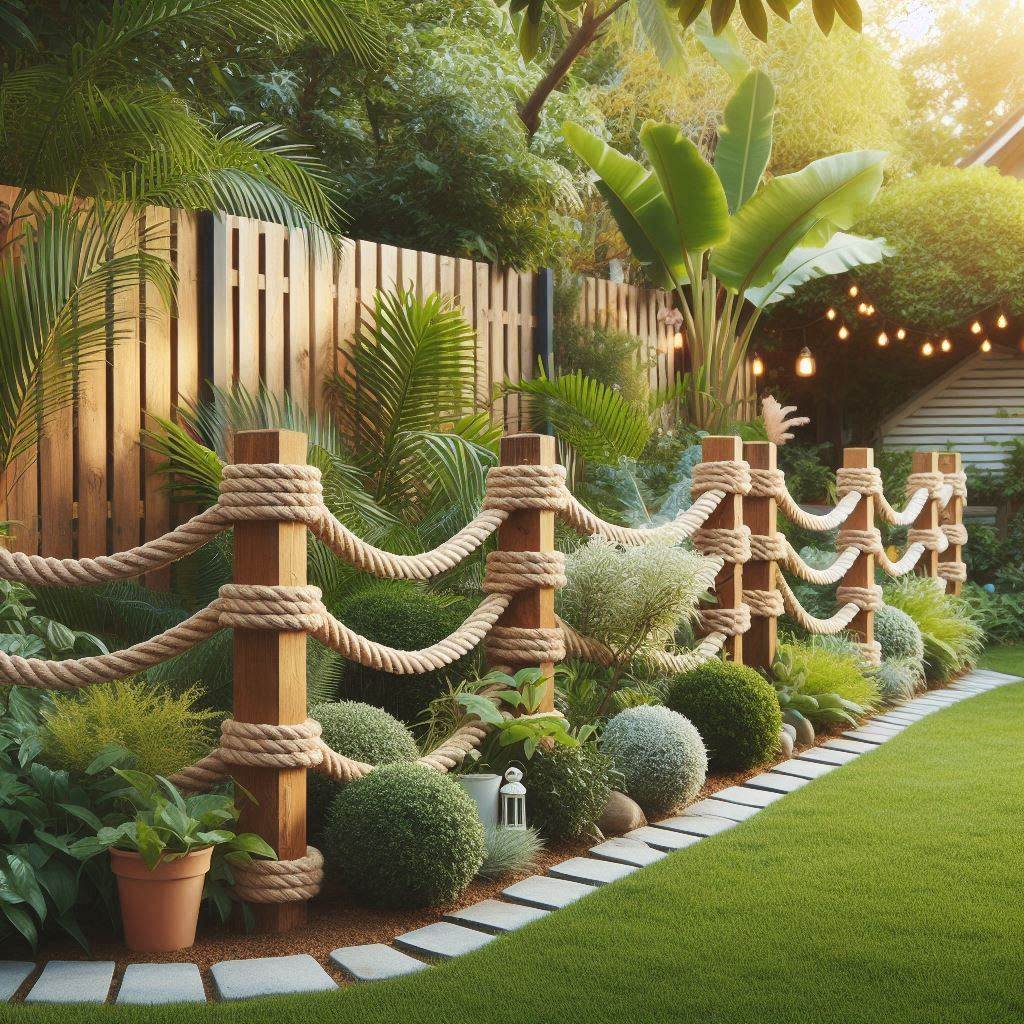
For a minimalist and eco-friendly approach, consider a rope fence. This option creates a subtle barrier and is perfect for marking property lines or defining garden areas.
Materials:
- Thick rope (natural fibers like hemp or sisal work well)
- Fence posts (treated wood or metal)
- Eye hooks or screw hooks
Construction Tips:
- Secure the fence posts into the ground at regular intervals.
- Attach eye hooks or screw hooks to the top of each post.
- Thread the rope through the eye hooks, creating a continuous loop along the fence line.
- Ensure the rope is taut and adjust the tension as needed.
13. Go Green with a Climbing Plant Trellis Fence
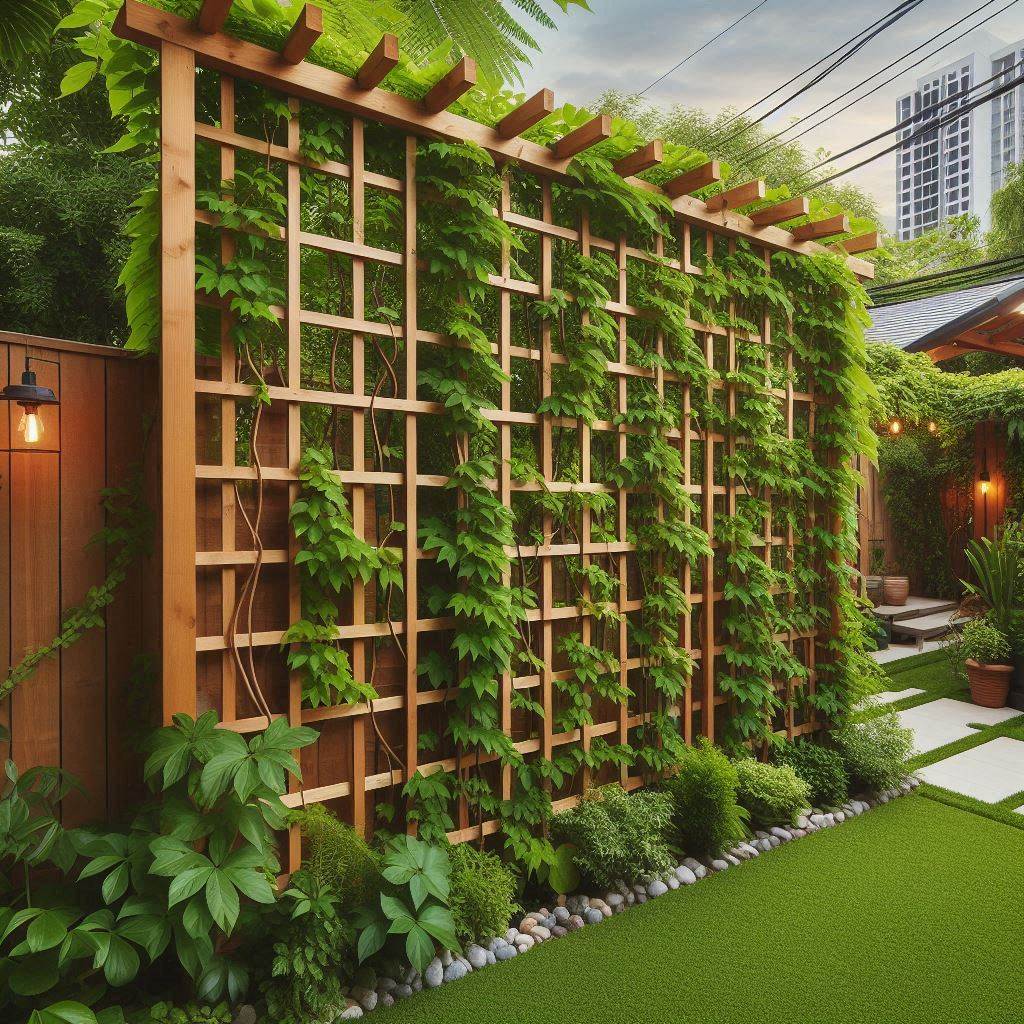
Transform your existing fence (or a wire mesh panel) into a living wall by creating a climbing plant trellis. This option provides privacy, improves air quality, and adds a touch of nature to your backyard.
Materials:
- Existing fence or wire mesh panel
- Climbing trellis (pre-made or DIY) made from wood or metal
- Climbing plants (vines, clematis, roses)
Construction Tips:
- Secure the climbing trellis to your existing fence or directly to fence posts if using a wire mesh panel.
- Choose climbing plants suited to your climate and sunlight conditions.
- Plant the chosen vines at the base of the trellis and train them to climb the structure as they grow.
Remember, these are just a few ideas to spark your creativity! With a little planning and resourcefulness, you can build a beautiful and functional DIY fence that enhances your backyard and reflects your unique style. Don’t be afraid to experiment, personalize your chosen design, and explore additional resources for inspiration.
14. Embrace Sustainability with a Recycled Plastic Bottle Fence
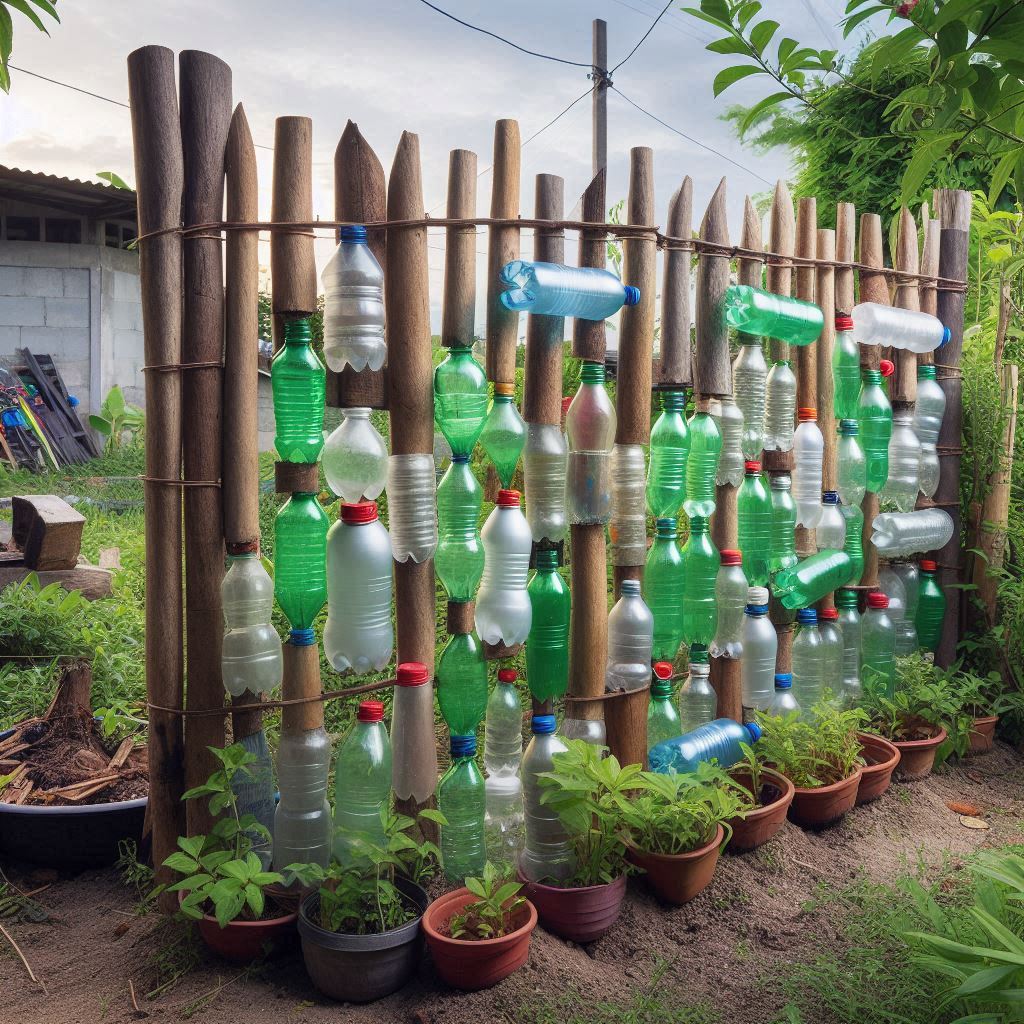
For an eco-conscious and colorful option, consider a recycled plastic bottle fence. This project offers a way to repurpose plastic waste while creating a unique and eye-catching barrier.
Materials:
- Used plastic bottles (various sizes and colors are ideal)
- Fishing line or twine
- Scissors or utility knife
- Fence posts (treated wood or metal)
Construction Tips:
- Wash and dry the plastic bottles thoroughly. Carefully cut off the bottom portion of each bottle to create a flat base.
- Punch holes near the rim of each bottle using a hole punch or heated nail (wear safety glasses!).
- Thread fishing line or twine through the holes, creating rows or patterns with the different colored bottles.
- Secure the strung bottles to fence posts using additional twine or wire.
15. Channel Tropical Vibes with a Bamboo Fence

For a touch of tropical flair and a naturally beautiful fence, consider using bamboo. Bamboo is a fast-growing and sustainable material that offers a unique aesthetic.
Materials:
- Bamboo poles (ensure they are properly dried and treated for outdoor use)
- Galvanized wire or cable ties
- Fence posts (treated wood or metal)
Construction Tips:
- Secure the fence posts into the ground at regular intervals.
- Cut the bamboo poles to the desired fence height.
- Bundle the bamboo poles together horizontally using galvanized wire or cable ties.
- Secure the bundled bamboo sections to the fence posts using additional wire or brackets.
16. Create a Secluded Oasis with a Climbing Shrub Maze
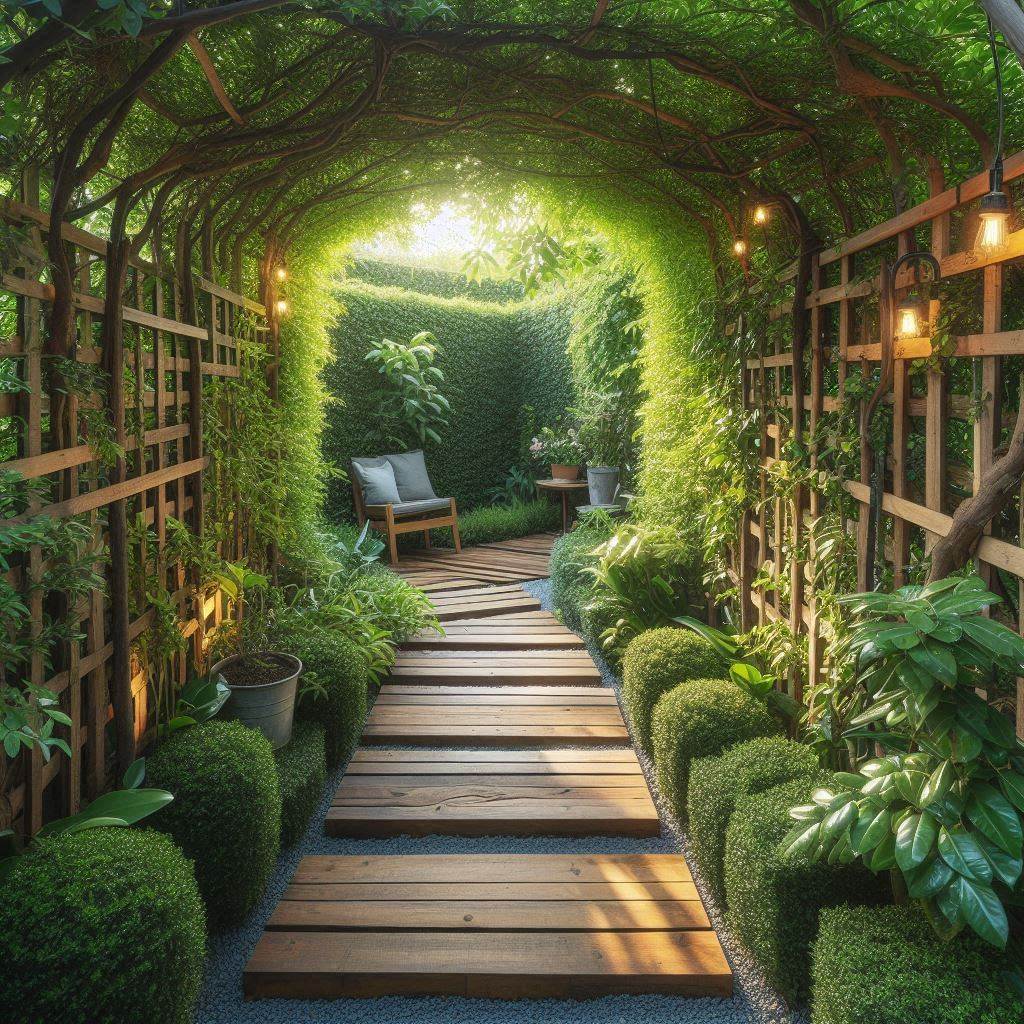
For a unique and privacy-enhancing option, consider creating a climbing shrub maze. This project utilizes fast-growing climbing shrubs to form a dense and beautiful barrier.
Materials:
- Sturdy trellis or lattice panels
- Fence posts (treated wood or metal)
- Climbing shrubs (fast-growing varieties like honeysuckle or Virginia creeper)
- Potting soil (if planting shrubs in containers)
Construction Tips:
- Secure the fence posts into the ground in a maze-like pattern, creating designated pathways.
- Attach trellis or lattice panels to the fence posts to provide support for the climbing shrubs.
- Plant climbing shrubs at the base of the trellis and train them to climb the structure as they grow. Consider using containers for added flexibility in placement.
17. Define Space with a Gabion Fence
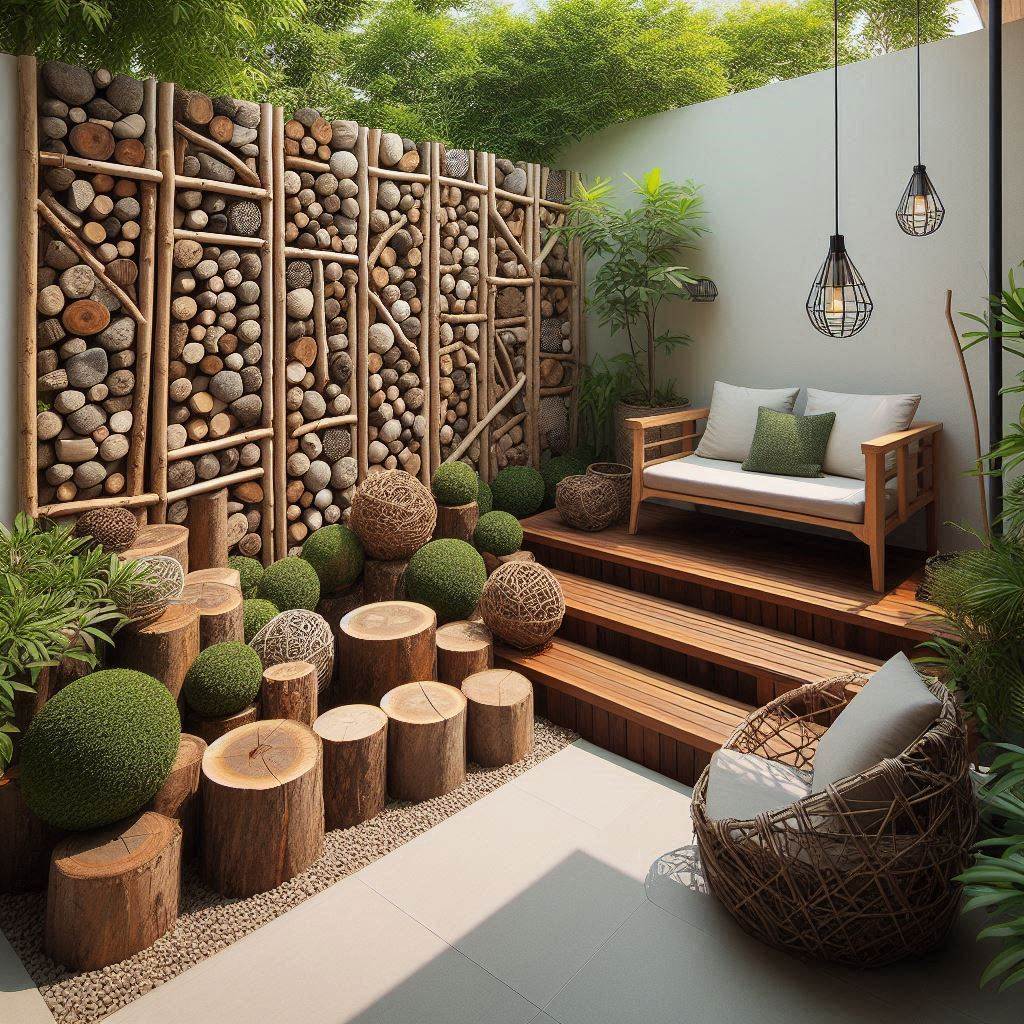
For a modern and low-maintenance option, consider a gabion fence. Gabion fences are constructed using wire mesh baskets filled with rocks or stones, creating a unique and visually appealing barrier.
Materials:
- Galvanized wire mesh baskets (appropriate size for your desired fence height)
- Decorative stones or rocks (various sizes and colors can add visual interest)
- Gloves (for handling rocks)
Construction Tips:
- Secure the fence posts into the ground at regular intervals.
- Interlock the gabion baskets to create the desired fence length and height.
- Fill the gabion baskets with decorative stones or rocks, ensuring a tight and secure fit.
18. Upcycle with a Corrugated Metal Fence
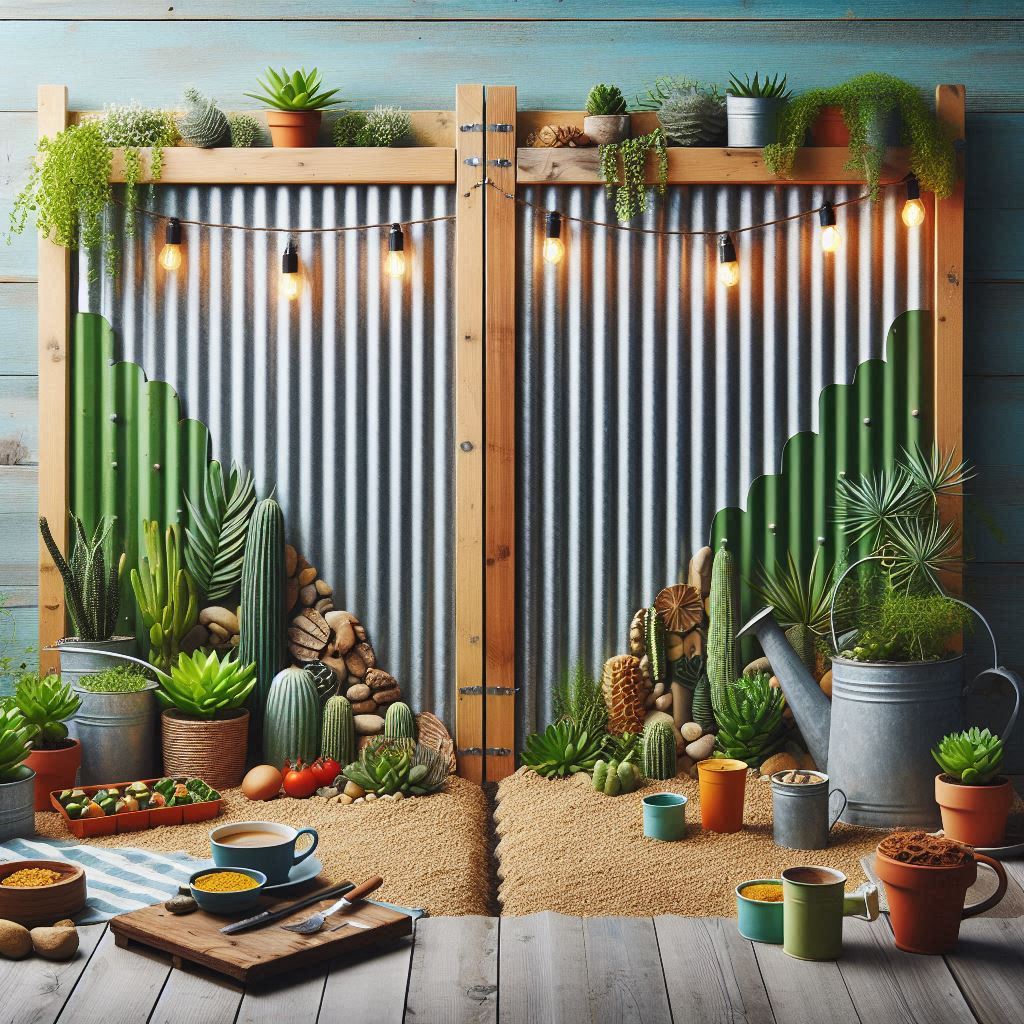
For a modern and industrial-inspired fence, consider using recycled corrugated metal sheets. This option offers a unique aesthetic and can be surprisingly affordable when using salvaged materials.
Materials:
- Corrugated metal sheets (galvanized or painted)
- Fence posts (treated wood or metal)
- Screws or rivets appropriate for metal
Construction Tips:
- Secure the fence posts into the ground at regular intervals.
- Cut the corrugated metal sheets to the desired fence height.
- Secure the metal sheets to the fence posts using screws or rivets, ensuring a weatherproof connection.
19. Embrace Minimalism with a Corten Steel Fence

For a modern and low-maintenance option with a unique weathering effect, consider a Corten steel fence. Corten steel develops a natural rust-like patina over time, creating a distinctive and artistic look.
Materials:
- Corten steel sheets (pre-cut or custom cut to size)
- Fence posts (treated wood or metal)
- Welding equipment (if installing the fence yourself) or professional installation
Construction Tips:
- Due to the specific properties of Corten steel, professional installation is recommended to ensure proper handling and welding techniques.
- Corten steel fence panels can be pre-fabricated or welded on-site to the desired specifications.
- Secure the Corten steel panels to fence posts using appropriate fasteners or welding techniques.
Remember, these are just a springboard for your creativity! With a little planning and resourcefulness, you can design and build design and build a beautiful and functional DIY fence that enhances your backyard and reflects your unique style. Don’t be afraid to experiment, personalize your chosen design, and explore additional resources for inspiration.
20. Craft a Cozy Retreat with a DIY Shade Sail Fence
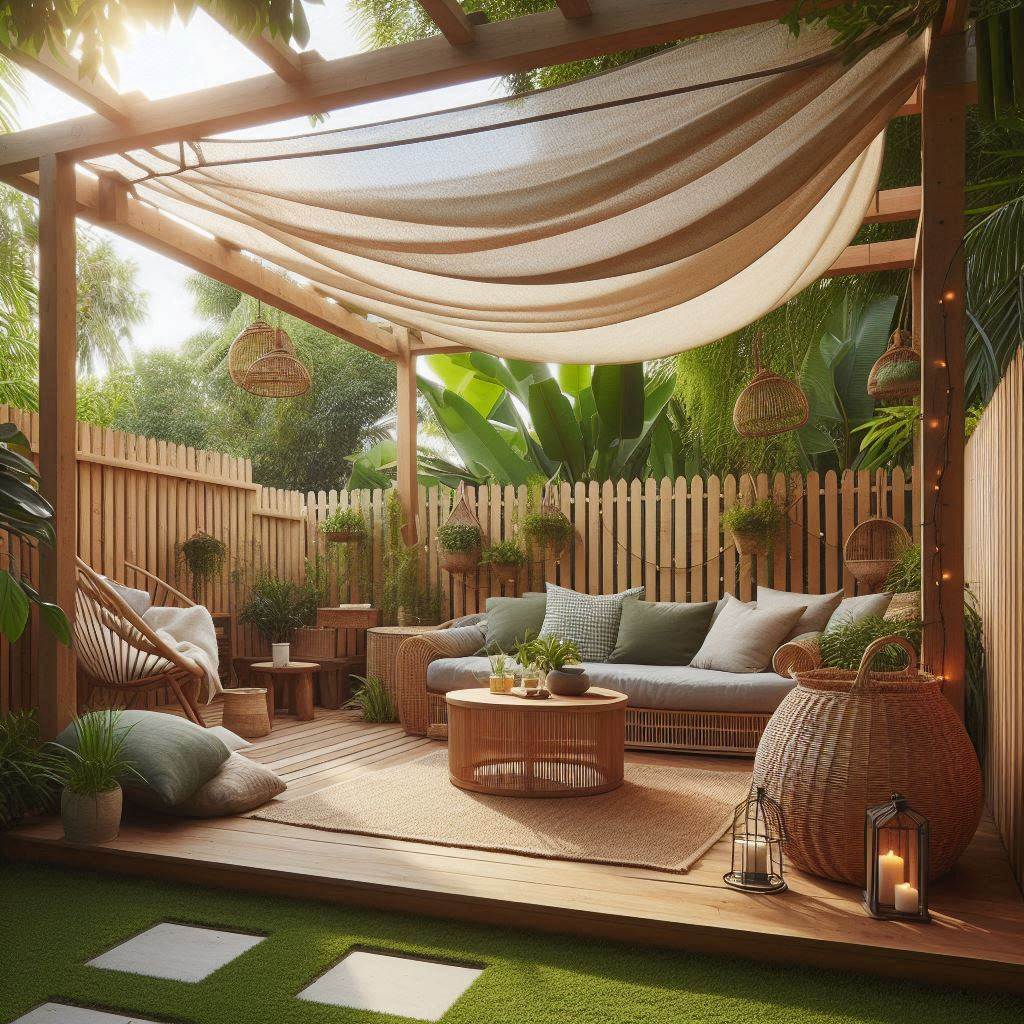
For a unique twist on privacy and sun protection, consider a DIY shade sail fence. This option offers a stylish and functional solution, creating a shaded haven in your backyard.
Materials:
- Shade sail fabric (waterproof and UV-resistant)
- Triangle rings or D-rings (stainless steel)
- Turnbuckles (stainless steel)
- Fence posts (treated wood or metal)
- Cable wire or rope (galvanized steel recommended)
Construction Tips:
- Secure fence posts into the ground at the desired locations for the shade sail corners.
- Ensure the posts are sturdy enough to support the tension of the shade sail.
- Attach triangle rings or D-rings to the corners of the shade sail fabric.
- Connect the D-rings to the turnbuckles, which are then connected to the cable wire or rope.
- String the cable wire or rope between the fence posts and the shade sail attachment points.
- Tighten the turnbuckles to create tension and ensure the shade sail is taut and secure.
21. Embrace Vertical Gardening with a Pallet and Succulent Wall
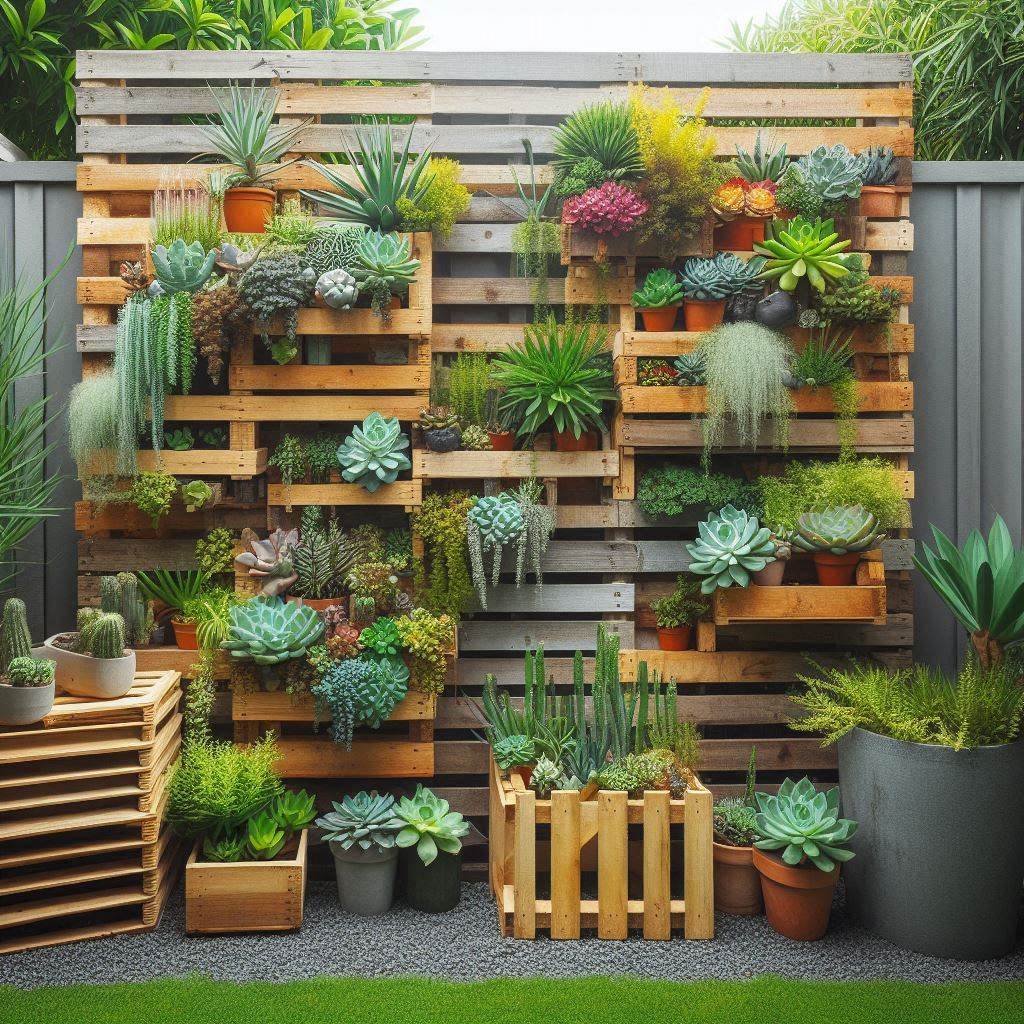
For a space-saving and low-maintenance privacy solution, consider a vertical garden using recycled pallets and succulents. This option provides a touch of greenery, enhances air quality, and offers a unique visual element.
Materials:
- Recycled wooden pallets
- Landscaping fabric
- Staple gun
- Succulent plants (various drought-tolerant varieties)
- Potting mix suitable for succulents
Construction Tips:
- Disassemble the pallet if necessary and remove any loose nails or staples. Sand down any rough edges.
- Line the back of the pallet with landscape fabric, stapling it securely in place. This helps retain moisture and prevents soil from leaking.
- Fill the front section of the pallet with succulent potting mix.
- Plant a variety of succulents directly into the potting mix, creating a visually appealing design.
- Secure the pallet to a fence, wall, or sturdy posts using appropriate hardware.
Conclusion
DIY fences offer a budget-friendly and creative way to add privacy, security, and beauty to your backyard. These ideas are simply a starting point – the possibilities are endless! Consider your personal style, desired functionality, and available materials to design a fence that reflects your unique taste.
Don’t be afraid to experiment and personalize your chosen design. You can add decorative elements like pebbles or small wind chimes to your living fence, stain or paint your recycled pallet fence in a bold color, or incorporate climbing flowers with different blooms into your chicken wire fence.
Have you built a DIY fence for your backyard? Share your project photos and tips in the comments section below! We’d love to see your creative ideas and inspire others to embark on their own DIY fence adventures.

